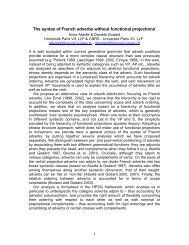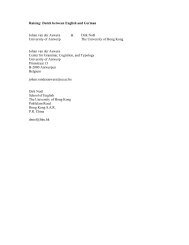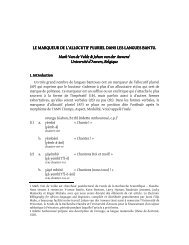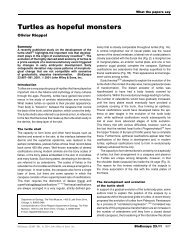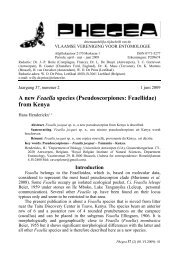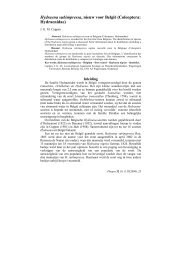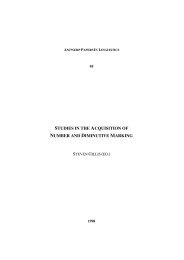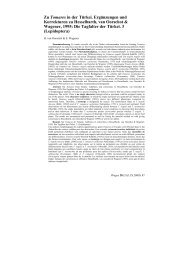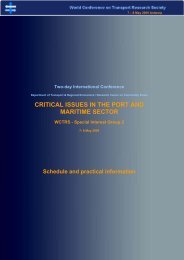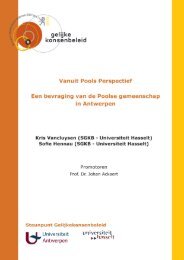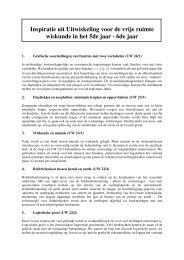Theodor2005.pdf
Theodor2005.pdf
Theodor2005.pdf
Create successful ePaper yourself
Turn your PDF publications into a flip-book with our unique Google optimized e-Paper software.
Cebochoerid Deciduous Dentitions 177<br />
deciduous dentition led us to re-examine the cebochoerid hypothesis in our phylogenetic<br />
analysis.<br />
The results of this phylogenetic analysis (Fig. 5) support a monophyletic Cetartiodactyla<br />
(with distinct artiodactyl and cetacean clades). Although Cetartiodactyla and<br />
Artiodactyla are each monophyletic, neither is strongly supported, both having decay index<br />
values of three (Bremer, 1994), and the decay index values of surrounding nodes indicate<br />
that alternative placements for Cetacea are not much longer: placing Cetacea as the sistertaxon<br />
to Hippopotamidae requires 15 steps more than in the shortest tree, as sister-taxon<br />
to the Anthracotheriidae costs 11 steps, and as sister-taxon to the Cebochoeridae costs<br />
10 steps. Given how few taxa can currently be scored for the deciduous dentition, and the<br />
amount of missing data in other key artiodactyl taxa for basicranial characters, the stability<br />
of these nodes is questionable, and additional data may alter the topology to favor artiodactyl<br />
paraphyly. The implication of these results is that further data from new fossils and<br />
from reanalysis of existing collections, especially for deciduous teeth, will be instrumental<br />
in documenting and understanding the morphological transitions in early whales and<br />
artiodactyls.<br />
The resemblance between juvenile cebochoerid premolars and the juvenile and adult<br />
teeth of archaeocete whales may be construed in two ways: either this feature is a synapomorphy<br />
that with additional ontogenetic and basicranial data, will support a relationship<br />
among cebochoerids, hippopotamids, and whales; or it represents a convergent morphology<br />
that is unique to cebochoerids among artiodactyls. Our data currently support the latter<br />
interpretation, but the support metrics indicate that our results are far from conclusive.<br />
If the whales and cebochoerids are closely related, then the characteristic adult dentition<br />
of derived archaeocete whales might represent a case of heterochrony. Heterochrony has<br />
been suggested (Thewissen and Williams, 2002) as a possible mechanism both for the<br />
evolution of monophyodont homodont teeth and for the elongation of the spine in whales.<br />
However, the argument for heterochrony in this case is predicated on a close phylogenetic<br />
relationship between cebochoerid artiodactyls and archaeocete whales, a relationship that<br />
requires additional morphological data to support it. Further data to test this hypothesis may<br />
be found in deciduous dentitions, dental eruption sequence, and basicranial morphology,<br />
particularly among other basal artiodactyls.<br />
A relationship between cebochoerids and whales would complicate our biogeographic<br />
and temporal understanding of these groups, and the earliest artiodactyls (and possibly also<br />
the earliest pakicetids) do not share the deciduous morphology of cebochoerid artiodactyls<br />
and archaeocete whales. Cebochoerids are only known from the early Eocene through early<br />
Oligocene fossiliferous deposits of Europe, whereas archaeocete whales are found in early<br />
Eocene deposits of Asia and middle Eocene of North America. Nonetheless, our findings<br />
highlight the need to both collect new fossil specimens and re-examine existing specimens<br />
for ontogenetic information.<br />
Results from molecular studies have stimulated morphological analysis of the whale–<br />
artiodactyl relationship, but many of those have focused on early whales and mesonychids<br />
with significantly less emphasis on the early artiodactyls. Molecular data cannot be collected<br />
for the vast majority of fossil species; thus, understanding the evolutionary transitions<br />
that took place in the earliest whales and artiodactyls will require a greater emphasis<br />
on morphological character recognition, especially in the many poorly known groups of<br />
Eocene artiodactyls.



